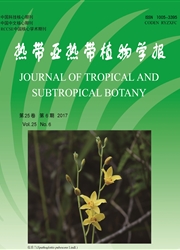

 中文摘要:
中文摘要:
为深入理解蕨类植物辐射式物种分化的分子适应机制,在时间框架下,采用位点模型和分支-位点模型对凤尾蕨科植物rbcL基因的进化式样进行了分析。通过比较模型M1a/M2a和M7/M8,在氨基酸水平上共鉴定出6个正选择位点:149I、251M、255V、282F、359S和375F, 其中位点282F对维持Rubisco功能有重要作用。分别检验凤尾蕨科的附生分支和水蕨类分支发现,前者不具适应性进化位点,而后者有两个位点(230A和247C)经历正选择。相对于荫蔽的光条件,水生生境可能对RbcL亚基的选择作用更强。另外,基于UCLD分子钟模型估算出的凤尾蕨科各分支分化时间表明,该科物种丰富度的辐射式增长发生在新生代渐新世,推测古、始新世最热事件可能对物种分化的形成也产生一定作用。这对认识薄囊蕨类如何应对被子植物兴起导致的陆地生态系统改变具重要意义。
 英文摘要:
英文摘要:
To further understand the molecular adaptation linked to fern radiation, evolutionary patterns of the rbcL sequences in the family Pteridaceae were examined using random-site and branch-site models along with the estimated time-scale of pteridaceous phylogeny. By comparing Models M1a/M2a and M7/M8 under random-site models, six amino acid sites (149I, 251M, 255V, 282F, 359S and 375F) were found to be positively selected. The site 282F plays an important role in maintaining Rubisco function. Under branch-site models, no adaptive site was identified in the epiphytic clade, whereas two sites(230A and 247C) were detected in the ceratopteridoid clade. In comparison with shade conditions, aquatic habitats may have imposed stronger selection on the pteridaceous RbcL subunits. Moreover, the phylogenetic tree reconstructed with uncorrelated lognormal distributed relaxed clock model shows that the pteridaceous fern radiations occurred during the Oligocene, suggesting possible roles played by the Paleocene-Eocene Thermal Maximum. These results provide new insights into how leptosporangiate ferns response to the terrestrial ecosystem changes caused by the rise of angiosperms.
 同期刊论文项目
同期刊论文项目
 同项目期刊论文
同项目期刊论文
 期刊信息
期刊信息
